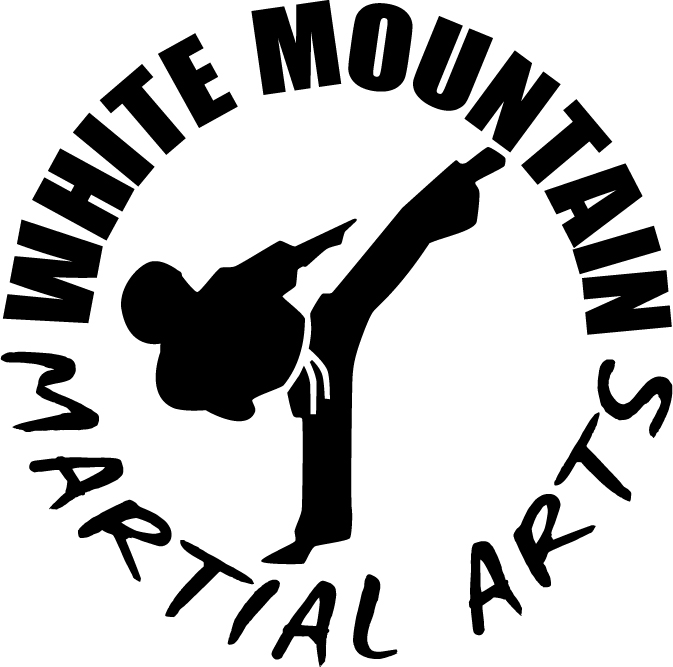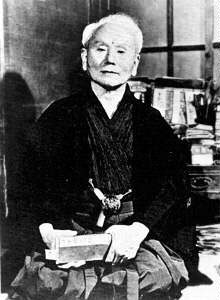
White Mountain Martial Arts
An Independent Shotokan Karate Program
Putting Martial Arts in its Proper Perspective in Today's World.
About White Mountain Martial Arts
We are an independent and eclectic Shotokan Karate Dojo. We opened in November 1997. We are a spin off of White Mountain Shotokan Karate and Sensei Mike Purcell, who moved away in 1997. Our style relies heavily on the three Ks of Karate:- "Kihon" (drills, stances, basics)
- "Kata" (forms, pre-set self defense techniques that graduate in difficulty with rank)
- "Kumite" (sparring, contact sport)
"All things evolve in order to survive."
Classes are currently held Wed. evenings in the function hall at the "Littleton Eagles Club" on Rt. 302 in Bethlehem, NH
Class dues are $10.00 per month with family discounts available.
Wed. 7:00 - 9:00pm.
Not sure if Karate is for you? Come in and try a week of classes for free. If you decide to join, you will gain self esteem, self confidence, and a better understanding of yourself through physical training. If you decide not, you have lost nothing.
Shotokan Kata (Forms)
Click on the form name for explanations of these forms!Our program uses eleven of these forms to take students progressively from beginner to black belt. The first form taught is Taikyoko Shodan, then all five Heian katas, followed by Kanku Dai, Bassai Dai, and Tekki Shodan. The last two forms are up to each individual student and are to be taken from the advanced forms list below. Although each student will vary, the average time frame for beginner to black belt is four years.
- Taikyoko (First Cause)
- Ten No Kata (form of the universe)
- Heian (Peaceful Mind)
- Bassai (Destroying a fortress)
- Chinte (rare hands)
- Empi (flight of the swallow)
- Gankaku (crane on a rock)
- Gojushiho (fifty-four steps)
- Hangetsu (crescent moon)
- Jiin (compassion and shadow)
- Jion (compassion and favor)
- Jutte (ten hands)
- Kanku (Look to the sky)
- Meikyo (bright mirror)
- Nijushiho (twenty-four steps)
- Sochin (strength and control)
- Tekki (Iron Horseman)
- Unsu (cloud hands)
- Wankan (king's crown)
Explanations for the Katas listed above are meant only as a guide and a reminder for those who train in these forms. They are not intended to replace a qualified instructor nor are they the written law for how to perform them. The movements of these forms are performed differently from style to style, and school to school, always check with your instructor about any variations. Any comments, suggestions, or to report a misprint, please feel free to contact me.
Books, Videos and Training Equipment
- Find Martial Art Related Books, Videos and Training Equipment at:
- Amazon.com
- Century Martial Arts
- Turtle Press
- AWMA (Asian World of Martial Arts)
- Barnes and Noble
- Yama Sporting Goods
- Kamikaze USA
- Tokaido USA
- Anshin Martial Arts Attire
- The Dragon's Choice
Martial Arts Info
- JKA @ Columbia University
- USF Shotokan Karate
- Shotokan For Everyone
- Shotokan Planet
- I.S.O.K.
- Ashihara Karate International
- Japan Karate-Do Ryobu-kai
- JKA Silicon Valley
- Karate Shorinkan
- Austrailian Karate Academy
- Intl. Shotokan Karate Fed.
- Fighting Arts.com
- American Samaurai.com
- Bujinkan Buyu Dojo
- Karate The Japanese Way
- Legend Karate
- Jung Do Taekwondo Academy
- A.K.I. Kenpo
- Matsubayashi Shorin-Ryu Karate
- Musashi Kyokushin-Mas Oyama Karate
- Budo Promotions
- Japanese-English Dictionary Server
- Judo Information Site
- National Karate & Kobudo Federation
- Taekwondo @ Columbia University
- Tsunami Dojo
- British Aikido Association
- George Dillman
- Uechi-ryu Karate: Martial Info Center
- National Institute of Pressure Point Arts
- Total Approach JKD
- Koryu.com
- Fight World
- Boston College Karate
- Ao Denkou Kai International
- International Modern Hapkido Federation
- Black Belt Magazine
- Kihon.com
- aBudokan Martial Arts Community
- AMAS magazine
- Web Boxing League
- Budo Seek: Martial Search Engine
- Blauer Tactical Systems
- Super Foot "Bill Wallace's" Home Page
- World Kobudo
- School of MartialArts
- World Korean Martial Arts Association
- Las Vegas School of Shotokan Karate
- Martial Warrior Forum
- Martial Arts Talk
- Kumite Kid.com
- Solid Fitness Martial Art Suppliers
- Club Self Protech S/D Products
- Kaze Jujutsu
- Szigg.net Web Directory
- World IL-DO-KWAN Federation: USA site

Early Karate Origins
Karate is an ancient martial art whose origins date back over one thousand years. Karate can trace its roots to the Chinese Shao Lin fighting art. The Shao Lin style arose from the training methods introduced by Dharma at the Shao Lin monastery. Designed to build strength and endurance, these methods helped the Shao Lin monks carry out their religion's strict discipline.
The Shao Lin style migrated to Okinawa, where the authorities forbade the use of weapons. The Okinawan style of "empty-hand" fighting and self-defense soon arose, combining Shao Lin with indigenous fighting techniques. This martial art was called karate in recognition of its Chinese origin. ("Kara" means "Chinese"; "te" means "hand".)
The development of modern karate under Gichin Funakoshi:
 Gichin Funakoshi was born in Okinawa in 1868, the same year as
Japan's Meiji Restoration. Introduced to karate as a boy,
Funakoshi's early training took place in complete secrecy --
at the time, the Okinawan government had banned the practice of
karate. Funakoshi eventually became a schoolteacher, training
in karate all the while. During this time, Okinawan karate emerged
from its seclusion to become a legally sanctioned martial art.
In 1922, the Japanese Ministry of Education held a martial arts
demonstration in Tokyo; the Okinawan Department of Education
asked Funakoshi to introduce Okinawan karate to Japan.
Gichin Funakoshi was born in Okinawa in 1868, the same year as
Japan's Meiji Restoration. Introduced to karate as a boy,
Funakoshi's early training took place in complete secrecy --
at the time, the Okinawan government had banned the practice of
karate. Funakoshi eventually became a schoolteacher, training
in karate all the while. During this time, Okinawan karate emerged
from its seclusion to become a legally sanctioned martial art.
In 1922, the Japanese Ministry of Education held a martial arts
demonstration in Tokyo; the Okinawan Department of Education
asked Funakoshi to introduce Okinawan karate to Japan.
Funakoshi did not get the chance to return to Okinawa. His demonstration made a powerful impression on the Japanese public; Funakoshi was soon beseiged with requests to further demonstrate and teach his art. Eventually, he had enough students to open a modest dojo in a Tokyo dormitory's lecture hall. Local universities began to take an interest in karate, and Funakoshi became a regular instructor at a number of them. The ranks of Funakoshi's students grew.
Recognizing that the karate he practiced had diverged from the Chinese fighting styles, Funakoshi changed the meaning of "karate" from "Chinese hand" to "empty hand." ("Kara" can also mean "empty".) The change was important to Funakoshi: the "empty hand" concept not only reflected the fact that its practitioners used no weapons, it also recalled the Zen process of perfecting oneself and one's art -- by emptying the heart and mind of earthly desire and vanity.
Funakoshi also set out to make karate more accessible to the public. He revised and streamlined the components of karate training, especially the kata, to make karate simple enough for everybody -- young and old, men and women.
Karate began to spread throughout Japan. In 1935, Funakoshi's supporters had pooled enough funds to erect the first free-standing karate dojo in Japan. The dojo opened the next year, with a sign over the door bearing the dojo's name: Shoto-kan.
("Kan" means "building." "Shoto" means "pine waves," which describes the sound of the wind rustling through pine trees. Funakoshi, who loved nature, was fond of this murmuring sound -- he considered it a kind of "celestial music." Therefore, he used the name "Shoto" to sign his calligraphy.)
In 1955, the Japan Karate Association was established -- Funakoshi's art had become a full-fledged karate organization. At the time, it was a modest one, with only a few members, a handful of instructors, and Funakoshi, who served as chief instructor. Gichin Funakoshi passed away shortly, in 1957. Since then, Shotokan students have carried on his spirit and teachings. The result: the JKA now has over 100,000 active karate students and approximately 300 affiliated karate clubs worldwide.
Sources:
Karate-do: My Way of Life, Gichin Funakoshi.
"Karate -- Yesterday and Today," Dynamic Karate, Masatoshi Nakayama.
Copyright (C) 1996, Bertrand Tzeng
Japan Karate Association at Columbia University
All rights reserved.
Revised: September 23, 1996.

History of Taekwondo
About 1,300 years ago, in the seventh and eighth century. The Korean peninsula was divided into three different kingdoms, Koguryo, Paekche, and Silla. Since Silla was the smallest kingdom it was constantly under invasion and harassed by its two much larger neighbors. During the reign of King Chin-Hung in the kingdom of Silla, the young aristocrat and warrior class formed an elite officer corps called the Hwa Rang-Do. This warrior corps, in addition to the ordinary training in spear, bow, sword, and hook, also trained themselves by practical mental and physical discipline and various forms of hand and foot fighting techniques. To harden their bodies, they would climb rugged mountains, swim in the turbulent rivers in the coldest months, and drove themselves unmercifully to prepare for the task of defending their kingdom. To guide themselves and give purpose to their knighthood, they incorporated a five-point code of conduct,set forth by their country's greatest Buddhist monk and scholar, Won Kang:
1) Be loyal to your king2) Be obedient to your parents
3) Be honorable to your friends
4) Never retreat in a battle
5) Make a kill
The Hwa Rang-Do corp inspired the people of Silla to rise and join with one another. The up rise of Silla's citizens defeated the barbarian like warriors of Korguryo and Paekche. During this time period, people of Silla held Hwa Rang- Do as a martial art. The first competition came out of this because they would use it as a source of entrertament, during the festivals. After the Silla kingdom, the Koguryo dynasty appeared. During this time the art was known as Soobek-Ki or Taek- Kyon. Annually, during the month of May, the king would hold a match of this form of unarmed combat. The winner would receive tons of food and jewelry for themselves and their villages. Certainly the dynasties of Silla, and Koguryo marked the start of Korean martial arts. In 1955, Tae Kwon Do was chosen as the new name of the national martial art of Korea by a board of instructors, historians and other prominent persons. The name was selected for its appropriate description of art:
Tae = to smash with the feetKwon = destroying with the hand or fist
Do = the way of life
Not only did this new name have close similarity to its ancient name of Tae-Kyon, but the name gave a new approach of nationalism to the art. Tae Kwon Do has been researched and developed in its style which is made up on ancient martial arts like; Taek- Kyon, Soo-Bak, T'ang-Su, Tae Kwon, Kwon-pup, and other various forms of Karate. A myriad of techniques have been added, especially in the variety of hand techniques and perfection of foot techniques.
Above info is from a page on Columbia University's Taekwondo site.